Some people say that the Golden Era of Japanese motorcycles was in the early 1980s, when everything seemed to come together—engine, chassis and price.
The Universal Japanese Motorcycle was in its heyday, an air-cooled in-line four being the main powerplant for all four Japanese companies. And one to hit the mark was this Yamaha Seca 650—the Seca name borrowed from the Laguna Seca (“Dry Lake”) raceway in California without so much as a by your leave, with the obvious intention of promoting a racy image.
Americans were just getting into the sportier side of motorcycles, where good handling meant as much as straight-line performance. The Europeans had been in this mode for many years, and the Japanese knew that they had to match the Ducatis, Moto Guzzis and BMWs. Which is why the Seca 650 appeared in Europe a year before it arrived here. We Americans got the engine in the cruiser-styled Maxim, but when the U.S. motorcycling press, staffed by an acid-tongued gang of serious go-fast types, heard that the Euros got the sport model, a lot of pressure was put on Yamaha Motor Corp. U.S.A. “Not fair,” the journalists said, “we get the 550 Seca, but not the 650.”
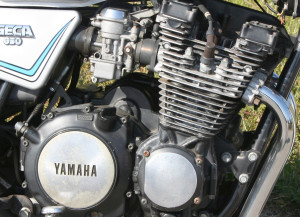
“For that, you have the Seca 750,” argued the folk in Cypress, California, Yamaha’s U.S. headquarters, referring to a genuinely nice motorcycle that was a touch too conservative for those who wanted to get a knee down in the corners. But the moto-magazines seemed quite irritated at the fact that the Euros had something we did not.
Corporate types have only one interest, profit, and the suits down in Cypress were not sure this was a wise move, as bringing in a new model is not just a matter of uncrating the bikes, but means jumping through all the government hoops, both EPA and DOT, and then advertising, training mechanics and stock-piling spares. But the world economy looked good, and motorcycles were selling quite well. So for 1982, the U.S. Yamaha dealers had three Secas on the floor, 550, 650 and 750—four, really, as there was also a twin-cylinder Seca 400.
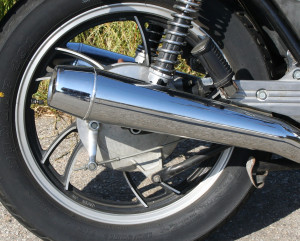
The 550 was the sportiest of the lot, with a chassis that loved to dive into a curve, and a chain final drive to maximize the horsepower. The 650 and 750 were both capable of lean angles in excess of 45 degrees, but the 5-speed gearboxes were connected to drive shafts, which put a touring slant on these two models.
Some changes had to be made in the 650 from the European model. To keep the federal inspectors happy, 32mm Hitachi constant-velocity carbs were used, which did not really seem to affect performance. However, in this land blighted by the national 55 mph speed limit, Yamaha felt it could save a couple of bucks by deleting the oil cooler that was useful in keeping engine temperature under control when racing through the Alps—but was not considered necessary for dawdling through the Rocky Mountains at semi-legal velocities. And the Cypress crew decided that the suspension should be softened up—great for city riding, not so good when the rider becomes aware that the curve has a decreasing radius.
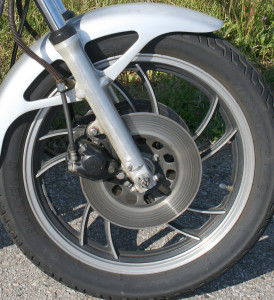
The UJM motor had four oversquare cylinders, good for revs, which could run to 9,500 rpm. Compression was a reasonable 9.2:1. Each cylinder had two valves, operated by two chain-driven overhead camshafts. The cam chain had an automatic tensioner, solving that problem, but the tappets needed shims, which were never popular with home mechanics.
The factory rated the engine at a rather optimistic 73 horsepower—dynamometers of the time were not equipped to measure output on shaft-driven motorcycles back then, so the magazines couldn’t get to the truth. Primary gears ran the power from the crankshaft to the countershaft, through the transmission and then out via the driveshaft. With a good, and preferably lightweight, rider on board, the bike could do a respectable quarter-mile in the 12s. The Seca 650 weighed only 500 pounds with five gallons of fuel in the tank, which was a selling point right there.
The engine and transmission were bolted into the full-cradle steel frame that was on the European version, stiff enough to enhance the cornering ability. The fork was, as mentioned before, on the soft side, with a rake of 28 degrees, trail of 4.5 inches. The twin shock absorbers had preload adjustment, but even at the max would bottom out. However, suspension units could be changed without too much of a hassle. The front alloy wheel with nicely curved spokes held a 19-inch tire and had two brake discs, each with a single-piston caliper. With the four- and six-piston calipers we see today, this sounds a bit archaic, but it was state of the braking art in those long-ago days. The rear wheel still slowed using a drum brake.
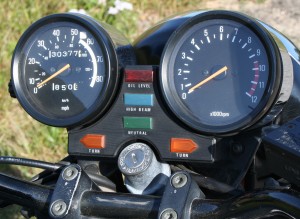
The seat was long and flat, the bars low and the footpegs set slightly rearward—very European. If you wanted the American sit-up-and-beg, buy the Maxim. Wheelbase was 56.5 inches, making it quite responsive in the corners.
All this could be had for a mere $3,000, while a BMW R65 cost a thousand dollars more. The XJ650 was not a runaway seller by any means, but provided the mildly sporting type with good performance and comfort for the long highways. This could take you to Alaska, as one tester did, or let you frolic discreetly along the tens of thousands of miles of twisty roads available in the Lower 48. Fuel consumption ran between 45 and 50 mpg, depending on the use of the throttle, so a 200-mile flog still left a lot of fuel in the tank.
The industry sold more motorcycles in America in 1982 than ever before—740,000, which seemed to promote a bit of recklessness in Yamaha. In a decision that defied fiscal explanation, the Seca 650 was not on the 1983 roster—it is bloody expensive to go through the cost of bringing a model to market and then drop it after just one year. Instead, Yamaha had gone to considerable extra expense to turn the Seca 650 into the XJ650LJ Turbo Seca, a fully faired powerhouse with a Mitsubishi turbocharger that produced, according to the factory, 90 horsepower. The brutal facts were that the Turbo Seca cost $5,000, $2,000 more than its non-turbo predecessor, weighed 65 pounds more, and its quarter-mile times were only half a second better than those of the normally aspirated model.
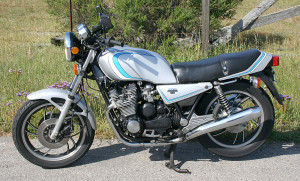
It should be added that Yamaha had greatly improved the suspension units on the Turbo, with an air-assisted fork, and shocks with rebound as well as preload adjustments. Had Yamaha dropped the turbo notion and just upgraded the 650’s handling, it might have become a real seller.
Year/Model: 1982 Yamaha XJ650RJ Seca
Owner: Paul Allen, San Luis Obispo, California
(This Retrospective article was published in the November 2012 issue of Rider magazine.)

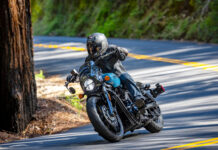






i have a red seca 650 im rebuilding it what a great bike
Mine’s a silver/blue, just like the one pictured. I now have clip-on bars which help with the comfort at high speeds. The XJ650 is an excellent bike and I can whoop a** on my friend’s Ninja 650. Amazingly reliable too.
I have one i bought brand new in 1984 ,left over dealer stock. I think I paid $1900 for it at the time. I love to start it in the spring and ride it all summer.
Bought mine as a 2-year old leftover in 1984 from PCP Yamaha in Sacramento for $2079.00. Owned it until around 2000, sold it with 102,000 miles on a 100% stock engine. Never broke down or left me stranded, ever. Carbs were worn out & wouldn’t idle but ran perfect off idle. Most reliable machine I’ve ever owned.
im sick reading this. i got mine for $1800 at Wilsons in Fresno in 87, new in box. I only had it 2 years, put 12g miles on it, and moved on. i wish I still had it.
I have one original from Fresno also. Got it from a widow in Fresno. Interested just call me, 805 312 5170. Thank you
still available?
I got mine as left over stock and paid $1499… I sold it in 1989 when I got married. It was not the big hit the Cycle Guide writers predicted. GPz’s came in 1982 as well. If they had rolled it out as a 1981, it might have had some momentum. The Turbo was a joke.
I am restoring one now. I sure wish I could buy another new one for $1499! This thing will cost me Ducati money by the time I’m done.
I have one if you want another. Complete, just sitting got it from widow next door. 805 312 5170. I drive a lot visiting kids, may del. if in S. West.
I bought mine new in 85 for about $2000. I still own it, and it’s still on the road. My son and I restored several other old bikes for him to ride (65 Honda 305 Superhawk, 72 Honda 500 Four). He wanted to buy something new, he look at several. One day he come home with a very nicely maintained silver and blue twin to my bike. He liked the ride and feel of my bike, so when he found one for sale, he bought it. It turns a lot of heads when two 82 Seca 650s drive by.
I just bought one in UK, it´s amazing at high revs, 34 years old and still got a lot of live inside!
Any idea where I can get parts for my 1982 Seca 650?
Any help will be appreciated
Hi Joe, what parts do you need?
Still got parts?
I just bought a 1982 XJ650 seca with ~3,000 original miles. First bike. Need help finding a manual, parts, etc…
Mine was silver/blue but i had it painted red. It was a good ride. Competent but not really fast and not a knee dragger. Sometimes i wish i’d kept it. It was a good all-around ride.
I bought a new 1983 Yamaha 650 Seca while I was in the Army stationed at Ft. Bliss, TX in El Paso. I loved that motorcycle and spent a lot of my free time on it.
I need non rusted exhaust headers for my 1982 xj650r seca
There are lots of groups to find parts in on Facebook. Ebay also helps. I found engine guards for my 83 900 Seca in Sweden, and traded the guy for them.
I bought one of these in late 1985 as a leftover from a Honda/Yamaha dealer on Route 23 in Pompton Plains, NJ, while a student at Montclair State College (now University). Fantastic bike! Had it 2 years – sold it – wish I hadn’t. Silver/blue as pictured. Fast! Hit some extra-legal speeds on route 287 between Morristown and Boonton… 🙂
looking for an Emissions Sticker……1982 Yamaha 650 Turbo Seca…..will buy now!!!!
Had an 82 silver and blue model, wife made me get rid of it before our children got old enough to be interested, gave it to the movers when we moved into our new house.
Just picked up a Red Cdn spec 82′. Identical to he one I bought new for $2300. Will have it on the road in a few months. Wonder if it as good as I remember? Such a pretty design. I find the ergonomics feel tailor made for someone 5 ft ten.
I have a 1981 yamaha xj 750 Sega great machine might be selling
Bought my new silver ‘82 XJ650RJ off of the dealer floor in June of ‘83 for $2100.00. The dealer threw in a small fairing. I commuted seventy miles round trip for eight years. Up graded shocks and fork springs along the way. Bike is fun, fast and dead reliable. In 2002 I added a modified, by me, ‘60 Jawa sidecar. Bike is just a fun ride, and has nearly 60,000 trouble free miles on the clock. I have two other bikes which is why the mileage is low. Just a great machine.
Love the Bike, I bought mine in Lompoc in ’83 for $2200. I still ride it and still love it. It has always been garaged and looks as good as ever but weeps a little oil after all these years.
I have one sitting, buy the whole bike for parts or ride. Call me @ 805 312 5170.Thank you
All very familiar stories. Mine was new in ’83, $1950.00 So many weekends with my wife on that bike. LOVED that headlight!My favorite thing was when a bunch of us would go out, I had to ride lead. NO one wanted me behind them. A car would flash their lights thinking my brights were on. When I’d flash my brights, watching them swerve was a little satisfying. I remember one mag saying it would kill a rabbit at 50feet. I SO regret not having that bike. Not great at anything, but good at everything. It’s almost painful looking at the pics. I do miss it.
My friend just bought me one here in New York for $400. All original.
My friend just picked up a 1982 for $400. All original, runs great with a clean title. Gave it to me. Awesome friend! We live in the state of New York. I’d like to post some pictures.
Had a blue 1985 650 30 years ago. Now just bought a silver one from States with one family owner. Best bike ever for handlebar to peg seating formula. Well done Yamaha
This article isn’t even really about the turbo bike at all.
Best bike I’ve ever owned. One took me and a future exwife from Minneapolis to Guatemala and back. We called her the ‘Panamerican pony’ Legendary ride.